The Hateful Eight (2015, Dir. Quentin Tarantino):
You only need to hang mean bastards, but mean bastards you need to hang.
— Kurt Russell, The Hateful Eight
“You got it?” “Yeah, I got it.” This exchange is uttered frequently throughout The Hateful Eight, the question usually coming from a man with a revolver, and the answer coming from a person staring at the revolver’s business end. Strip away all the colorful dialogue, the indulgent back-and-forth between his characters, and Quentin Tarantino’s movies boil down to this — barked orders, guns, violence. But ignoring the dialogue is ignoring the point of a Tarantino film. His characters are full of talk, puffed up with opinion and ego, always saying enough to land themselves in squirmy situations, and never given quite enough time to talk their way out. The Hateful Eight is as pure Tarantino as anything he’s done for some time, which is to say it’s existentialist New Wave meets grindhouse cinema. Everyone gets a chance to gab, genre conventions get fiddled with, a few ironic tunes pop up on the soundtrack, suspense coils around us, and then out pop the guns, and here come the blood sprays, guts perforated with bullets, heads separated from bodies with well-aimed shotgun blasts.
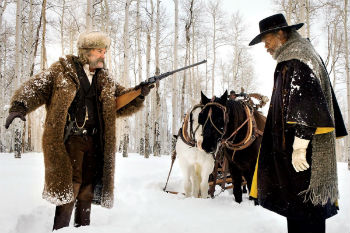 The Hateful Eight has the blood and guts, but before we get there we have a whole bunch of talk. Tarantino held a reading of the original screenplay in LA last year, and fittingly enough, it’s a piece well-suited to the stage. Mainly confined to one set, expansive with patter, the story is an elaboration on the tavern scene from Inglorious Basterds (2009), with a motley crew converging on a post-Civil War haberdashery in Wyoming, cussing, sussing and discussing each other. Despite the title, the action is centered on four characters: bounty hunter John “The Hangman” Ruth (Kurt Russell), his prisoner Daisy Domergue (Jennifer Jason Leigh), who is en route to a well-deserved noose in Red Rock, and the two strangers he picks up along the way, Major Marquis Warren (Samuel L. Jackson) and Chris Mannix (Walton Goggins). Warren is a Union vet and fellow bounty hunter who carries an impressive letter from Lincoln alongside the corpses of his quarry, while Mannix is a yee-haw descendant of Confederate marauders, who claims to be the new sheriff of Red Rock. Given that the bounty on Daisy is a hefty $10,000, Ruth is feeling mighty jittery about his traveling companions, and Warren and Mannix’s natural antipathy (not to mention Daisy’s frequent uses of the n-word) only increases the tension. When the quartet finds themselves snowed in at Minnie’s Haberdashery alongside four other strangers, at least one of whom is not who he claims to be, it’s clear that it’s going to be one long dark night, with scant hope that anyone will emerge unscathed.
The Hateful Eight has the blood and guts, but before we get there we have a whole bunch of talk. Tarantino held a reading of the original screenplay in LA last year, and fittingly enough, it’s a piece well-suited to the stage. Mainly confined to one set, expansive with patter, the story is an elaboration on the tavern scene from Inglorious Basterds (2009), with a motley crew converging on a post-Civil War haberdashery in Wyoming, cussing, sussing and discussing each other. Despite the title, the action is centered on four characters: bounty hunter John “The Hangman” Ruth (Kurt Russell), his prisoner Daisy Domergue (Jennifer Jason Leigh), who is en route to a well-deserved noose in Red Rock, and the two strangers he picks up along the way, Major Marquis Warren (Samuel L. Jackson) and Chris Mannix (Walton Goggins). Warren is a Union vet and fellow bounty hunter who carries an impressive letter from Lincoln alongside the corpses of his quarry, while Mannix is a yee-haw descendant of Confederate marauders, who claims to be the new sheriff of Red Rock. Given that the bounty on Daisy is a hefty $10,000, Ruth is feeling mighty jittery about his traveling companions, and Warren and Mannix’s natural antipathy (not to mention Daisy’s frequent uses of the n-word) only increases the tension. When the quartet finds themselves snowed in at Minnie’s Haberdashery alongside four other strangers, at least one of whom is not who he claims to be, it’s clear that it’s going to be one long dark night, with scant hope that anyone will emerge unscathed.
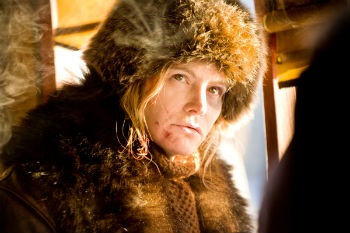 If this sounds familiar, you’re right, and Tarantino knows it. Yes, the Hateful Eight (which he has proclaimed to be his last movie) is one of those summation films. Tarantino brings all his stylistic tics to the party: chapter titles sprinkled throughout, unexpected flashbacks, gleeful geysers of gore, cocky and craven characters, and that dialogue, of course. It’s basically Reservoir Dogs (1993) redux, which shouldn’t be a problem with most audiences, seeing as how they’ve gobbled up the warmed-up leftovers offered by Star Wars: The Force Awakens. Like Dogs, Hateful Eight goes into bleak territory, where every semi-noble deed doesn’t go unpunished, just about every character is irredeemable (the title is truth in advertising), and the violence doesn’t set things right so much as it clears the boards. Plowing the same ground can prove to be fertile if you’re an auteur — Hitchcock has done it a few times in his career — and Tarantino definitely thinks of himself as an auteur. From the bubblegum title font that announces this is his eighth film, to the use of spaghetti western maestro Ennio Morricone’s music for the soundtrack, to his usual cast of legacy players (Russell, Jackson, Tim Roth, and Michael Madsen among them), to the extravagant decision to film what is essentially a one-set play in the widescreen scope of Super Panavision 70mm, Tarantino wants us to be fully aware of his quirky sensibilities from the get-go.
If this sounds familiar, you’re right, and Tarantino knows it. Yes, the Hateful Eight (which he has proclaimed to be his last movie) is one of those summation films. Tarantino brings all his stylistic tics to the party: chapter titles sprinkled throughout, unexpected flashbacks, gleeful geysers of gore, cocky and craven characters, and that dialogue, of course. It’s basically Reservoir Dogs (1993) redux, which shouldn’t be a problem with most audiences, seeing as how they’ve gobbled up the warmed-up leftovers offered by Star Wars: The Force Awakens. Like Dogs, Hateful Eight goes into bleak territory, where every semi-noble deed doesn’t go unpunished, just about every character is irredeemable (the title is truth in advertising), and the violence doesn’t set things right so much as it clears the boards. Plowing the same ground can prove to be fertile if you’re an auteur — Hitchcock has done it a few times in his career — and Tarantino definitely thinks of himself as an auteur. From the bubblegum title font that announces this is his eighth film, to the use of spaghetti western maestro Ennio Morricone’s music for the soundtrack, to his usual cast of legacy players (Russell, Jackson, Tim Roth, and Michael Madsen among them), to the extravagant decision to film what is essentially a one-set play in the widescreen scope of Super Panavision 70mm, Tarantino wants us to be fully aware of his quirky sensibilities from the get-go.
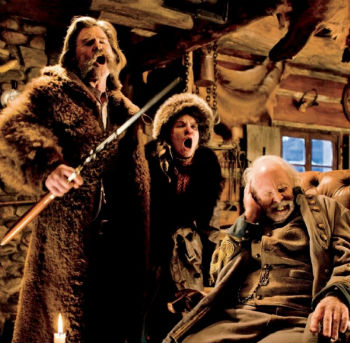 To his credit, Tarantino knows his cinema, and there’s a ton of fun influences at work in The Hateful Eight. The setting and mounting claustrophobia (as well as Russell’s presence) remind us of John Carpenter’s The Thing (1982), while the bleakness and lack of moral compunction (as well as Morricone’s score) recall Sergio Corbucci’s snow-bound Western The Great Silence (1968). Ruth and Warren’s attempts to divine the truth based on random clues — a jellybean on the floor, a pot of well-cooked stew — mark the plot as a locked-room mystery out of Agatha Christie. The actors often seem like they’ve blundered in from entirely different films. Russell does his best John Wayne (circa The Searchers), while Leigh snarls and leers and howls like an animal with rabies. As Red Rock’s chattily polite hangman, Roth channels Christoph Waltz; Demián Bichir mines cliché for comedy as a squinty, grunty Mexican caretaker; Bruce Dern underplays it as a crusty Confederate general; and Madsen brings cigarette-soaked weariness to his part, even though he’s costumed like he’s in a silent-era cowboy film. Gleefully presiding over this stylistic soup, Tarantino goes heavy on the staginess of his scenario, his characters even more verbose than usual, the dialogue getting repetitive, gags performed over and over (including an obnoxious bit about the door to the haberdashery repeatedly getting broken). It’s as if Samuel Beckett decided to go pulp. Tarantino even goes so far as to narrate stage directions in the film’s second half (it beats him appearing in a cringeworthy cameo, at any rate). Tying it all together is plenty of ribald commentary on racism and our country’s perpetual History of Violence. The Hateful Eight is the latest in Tarantino’s recent line of revisionist history movies, and its overriding message is how our notions of patriotism, honor, and justice are all a “liar’s heartbreaking promise” which merely provide an excuse for atrocities of every stripe. Jackson is particularly edgy as the put-upon black man who turns out to be perhaps the meanest son of a bitch of all of them; his monologue (and accompanying flashback) that concludes the film’s first half is obscene, nasty, comedic, and in extremely bad taste. In short, everything you would expect from a Tarantino joint.
To his credit, Tarantino knows his cinema, and there’s a ton of fun influences at work in The Hateful Eight. The setting and mounting claustrophobia (as well as Russell’s presence) remind us of John Carpenter’s The Thing (1982), while the bleakness and lack of moral compunction (as well as Morricone’s score) recall Sergio Corbucci’s snow-bound Western The Great Silence (1968). Ruth and Warren’s attempts to divine the truth based on random clues — a jellybean on the floor, a pot of well-cooked stew — mark the plot as a locked-room mystery out of Agatha Christie. The actors often seem like they’ve blundered in from entirely different films. Russell does his best John Wayne (circa The Searchers), while Leigh snarls and leers and howls like an animal with rabies. As Red Rock’s chattily polite hangman, Roth channels Christoph Waltz; Demián Bichir mines cliché for comedy as a squinty, grunty Mexican caretaker; Bruce Dern underplays it as a crusty Confederate general; and Madsen brings cigarette-soaked weariness to his part, even though he’s costumed like he’s in a silent-era cowboy film. Gleefully presiding over this stylistic soup, Tarantino goes heavy on the staginess of his scenario, his characters even more verbose than usual, the dialogue getting repetitive, gags performed over and over (including an obnoxious bit about the door to the haberdashery repeatedly getting broken). It’s as if Samuel Beckett decided to go pulp. Tarantino even goes so far as to narrate stage directions in the film’s second half (it beats him appearing in a cringeworthy cameo, at any rate). Tying it all together is plenty of ribald commentary on racism and our country’s perpetual History of Violence. The Hateful Eight is the latest in Tarantino’s recent line of revisionist history movies, and its overriding message is how our notions of patriotism, honor, and justice are all a “liar’s heartbreaking promise” which merely provide an excuse for atrocities of every stripe. Jackson is particularly edgy as the put-upon black man who turns out to be perhaps the meanest son of a bitch of all of them; his monologue (and accompanying flashback) that concludes the film’s first half is obscene, nasty, comedic, and in extremely bad taste. In short, everything you would expect from a Tarantino joint.
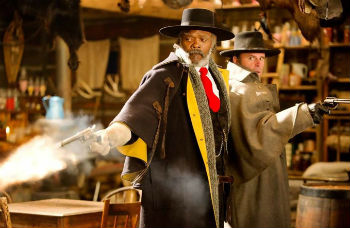 When we finally arrive at the shootings, the hacked-off limbs and the death rattles, it’s all hard-hitting (although nowhere near as grisly as some critics might lead you to believe — apart from some upchucks of blood worthy of South Park, it’s tame compared to modern horror movies). Still, it’s difficult to work up much of an emotional reaction. Due to the nature of the movie’s central mysteries, most of the characters remain ciphers until crucial moments, and by then they’re too busy getting blown away. The Hateful Eight is one strange mix, indeed: ugly and scabrous and digressive, it’s paced like an elegant art house film, taking its time as it waddles up to its major revelations, even throwing in a flashback with a whole new set of characters that is about twice as long as it needs to be. While the film doesn’t drag, the payoff doesn’t necessarily merit the nearly two hours of build-up. Tarantino is in baroque mode here, and by the time we have guts exploding and Jackson groaning, “You gonna make a deal with this diabolical bitch?” all of it shot in ludicrous slow motion, the flourishes all but overwhelm the plot.
When we finally arrive at the shootings, the hacked-off limbs and the death rattles, it’s all hard-hitting (although nowhere near as grisly as some critics might lead you to believe — apart from some upchucks of blood worthy of South Park, it’s tame compared to modern horror movies). Still, it’s difficult to work up much of an emotional reaction. Due to the nature of the movie’s central mysteries, most of the characters remain ciphers until crucial moments, and by then they’re too busy getting blown away. The Hateful Eight is one strange mix, indeed: ugly and scabrous and digressive, it’s paced like an elegant art house film, taking its time as it waddles up to its major revelations, even throwing in a flashback with a whole new set of characters that is about twice as long as it needs to be. While the film doesn’t drag, the payoff doesn’t necessarily merit the nearly two hours of build-up. Tarantino is in baroque mode here, and by the time we have guts exploding and Jackson groaning, “You gonna make a deal with this diabolical bitch?” all of it shot in ludicrous slow motion, the flourishes all but overwhelm the plot.
 “Anybody opens their mouth, gonna get a bullet. Anybody moves a little weird….little sudden — gonna get a bullet. Not a warning. Not a question; a bullet. Let me hear you say, ‘I got it’.”
“Anybody opens their mouth, gonna get a bullet. Anybody moves a little weird….little sudden — gonna get a bullet. Not a warning. Not a question; a bullet. Let me hear you say, ‘I got it’.”
Still, for all its knottiness and shortcomings, The Hateful Eight makes for a fine splattery time at the movies. Tarantino might be covering old ground, but his flamboyance is inclusive: he wants us to get off on the indulgences of pulp cinema as much as he does. If nothing else, he extracts fine performances from his actors, and the sneaky MVP this time is Goggins. Both dopey and wily, he earns most of the film’s best laughs, even while his character undergoes the closest thing to a change as the story progresses. While Tarantino has historically been more about the telling than the showing, his showing has grown more sophisticated, and with the help of the redoubtable cinematographer Robert Richardson, The Hateful Eight has a fluidity in camera movement and framing missing from many of his previous pictures. Your level of enjoyment will likely hinge on how you respond to the film’s racial and sexual politics, which don’t stand up to a whole lot of scrutiny. It’s one thing when outrage is channeled into groovy revenge fantasies as it is in Inglorious Basterds and Django Unchained, but you might respond differently when those same ideas are appropriated here in the service of punch lines. Leigh in particular gets the worst of it; her character is an almost comical commentary on her career-long propensity for selecting masochistic roles, as Daisy is humiliated and beaten in almost pornographic detail throughout. By the end, caked with others’ blood, most of her teeth missing, cackling like a harpie, she’s a parody of a parody. You might be able to laugh it all off — after all, none of these characters are paragons of virtue — and yet it’s saying something that she’s the most demonized figure in the movie.
You could go meta on this meta-commentary, and imagine Tarantino chuckling at the thought of people getting in a huff over such provocations. Certainly he seems to relish the ambivalence of the film’s ending, where a bit of “frontier justice” which would be an affront to any code of civilized behavior is framed as a triumphant moment. Or at least, it seems as if we’re meant to take it that way, until we conclude with a recital of that letter to Major Warren from President Lincoln, only by now it’s clear that neither the letter or Warren is what it seems to be. “There won’t be many coming home,” Roy Orbison croons over the closing credits, and as is the custom with a Tarantino movie, our parting emotion is one of cool irony. Piling bald-faced lies atop plain dirty behavior, The Hateful Eight could be seen as some sort of critique on our propensity for violence, but it’s probably more accurate to take it in as the latest outpouring from Tarantino’s cine-crazy id, where everything ends up being profane and irreverent. More than ever, he’s locked into his own head, and while it still remains an invigorating place to be, it might pay off for him to include a little more substance and a mite less self-indulgence next time.

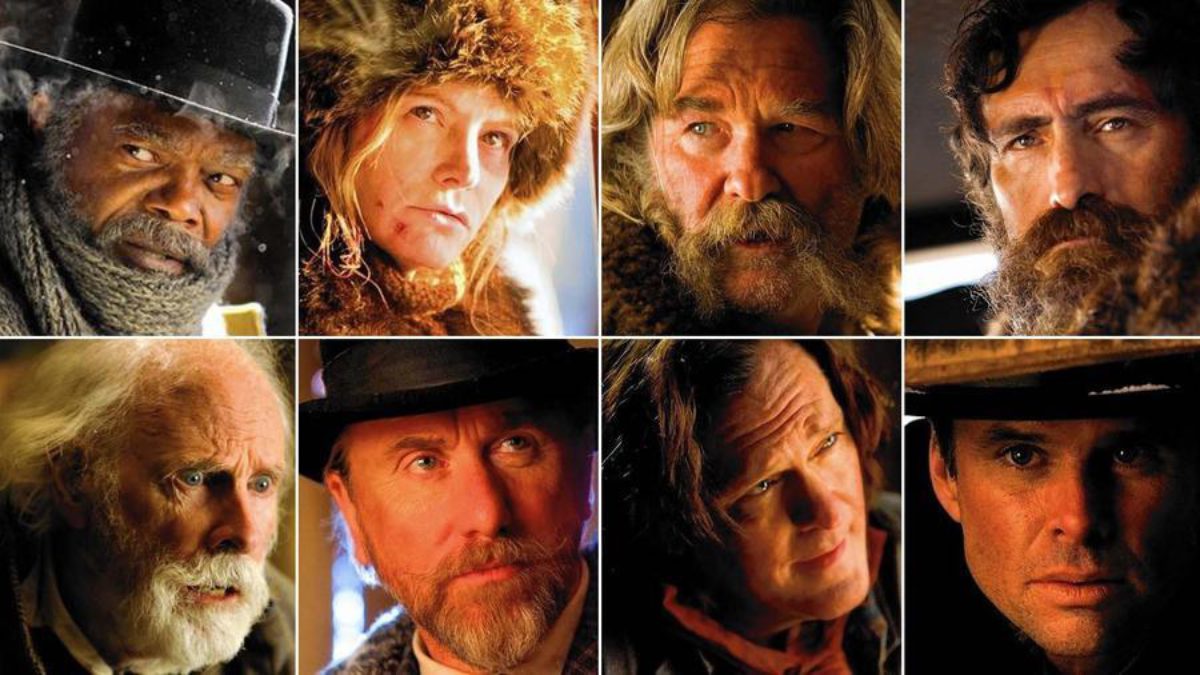
Comments
"Once Upon a Time in...Hollywoord" Film Review -Camera Roll
[…] of pre-Civil War slavery. Based on a script originally performed as a play reading, the stagey Hateful Eight (2015) was essentially a remake of […] Read More[…] of pre-Civil War slavery. Based on a script originally performed as a play reading, the stagey Hateful Eight (2015) was essentially a remake of Reservoir Dogs (1993), only with more cartoonish gore and some […] Read Less